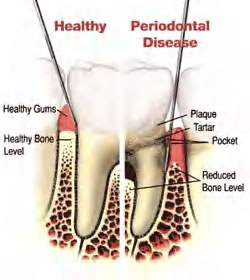Gum disease is a very common condition caused by the presence of bacteria within the dental plaque on the surface of your teeth. Because the symptoms of gum disease are often very subtle, they can be easy to overlook. Even if you have a beautiful smile with perfect teeth, regular visits to your dentist are essential for helping to ensure the health of your gums.
The Progression of Gum Disease
Gingivitis
In its early stages, gum disease is known as gingivitis. At this point in the disease state, plaque and tartar have accumulated on your teeth and caused inflammation of your gums. You may experience bad breath, swelling or tenderness of your gum tissue, or bleeding when you brush or floss your teeth. It is important to seek treatment if you notice any of these symptoms, as the progression of gum disease can be stopped and actually reversed at this stage.
Periodontitis
If gingivitis goes untreated, the disease will inevitably spread below the gumline and begin to destroy the bony tissues that support your teeth. Once the bone is affected, it becomes known as periodontitis. You may notice slight worsening or increased frequency of the symptoms of gingivitis, as well as a receding gums. As periodontitis progresses and the supporting bone continues to erode, your teeth may begin to feel loose or fit together differently. By the time you experience these more noticeable symptoms, extensive and irreversible damage has likely already occurred.
The diagram below helps illustrate the unseen effects of untreated gum disease.

Notice that the affected areas of the tooth are primarily below the gumline, where they are hidden from sight. This kind of damage may only be detectable by a professional exam including x-rays.
Prevention
Although gum disease is estimated to affect nearly 50% of the adult population, it can be prevented by practicing good oral hygiene.
- Visit your dentist regularly for exams and cleanings.
- Brush your teeth at least twice daily.
- Floss daily to reduce plaque buildup between your teeth.
Treatment
If you are diagnosed with gum disease, Dr. Patel will explain a treatment plan to help restore your gum health and protect your teeth.
First, you will need a special deep cleaning that goes beneath your gums to remove plaque and tartar buildup. This is called “scaling” or “root planing”, and it is generally performed with anesthetic for your comfort. This kind of thorough cleaning is usually spread out over several appointments, as it can take hours to complete. You may also be prescribed an antibiotic to address infection of the soft tissues.
Following treatment, you will need to bolster your dental care habits or risk a reoccurrence. You will need to have professional teeth cleanings more often—every two to four months instead of every six months. You will also need to step up your home dental care habits, including flossing every day. Dr. Patel can also provide suggestions for home appliances that will help you keep your gum disease from returning or worsening.
Gum Disease and Whole Body Health
Your oral health has a profound effect on the health of your whole body. The last decade has seen a focused effort by the American Academy of Periodontology to increase public awareness that untreated gum disease can wreak havoc on your general health. Research has linked gum disease to other chronic inflammatory conditions, including but not limited to: diabetes, Alzheimer’s disease, and cardiovascular disease.
Contact our office or use our convenient Make an Appointment page to help keep gum disease at bay.


